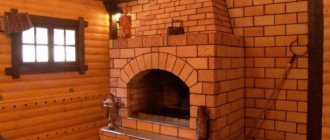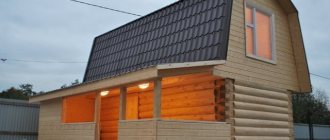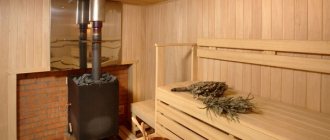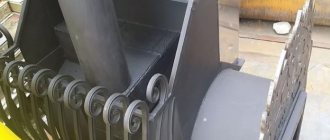Made of brick
A brick stove is a classic option for arranging a bathhouse. The quality of its work depends on the size, maximum heating temperature and the material from which it is made.
Brick stove
Advantages:
- the main advantage of a brick stove is the ability to retain heat for a long time after the heating has stopped;
- It protects the walls of a room better than metal ones from fire;
- creates high-quality steam;
- a high level of heat transfer allows for better heating of large areas;
- The brick walls of the heater do not allow combustion products to pass through.
Flaws:
- due to its large dimensions and weight, a solid foundation is required;
- The heating period for a brick stove is approximately 3 hours;
- large sizes take up a lot of free space in the bath;
- high cost due to the use of different types of materials.
Similarities and differences
When deciding which stove is better, the first thing you need to do is determine its functional tasks, because it will depend on them what is more suitable for the homeowner in each specific case.
All designs operating on solid fuel have a number of identical parameters:
- Both metal and brick products will have an open flame inside the firebox.
- At the moment when the structure body heats up, the room is filled with warm air and a comfortable temperature is created in the rooms.
- Products of fuel combustion are discharged through the chimney pipe.
- The chimney pipe must have the correct draft, otherwise the stove will not work properly.
- The combustion process is possible only if oxygen is supplied.
A metal and brick oven has a number of differences that are worth paying attention to. First of all, the difference lies in the material used to make the body of the heating device. In the first case, it can be cast iron or steel, and in the second - exclusively brick.
Nice cast iron stove
Many people wonder why iron stoves heat a room faster than brick stoves. The answer to this is quite simple and lies in the thickness of the housing walls: the smaller it is, the faster the structure warms up. Steel or metal can be very hot, while brick is an inert material and due to its greater thickness it does not heat up as much.
At the same time, if a metal stove gives off heat exclusively during the combustion of the flame inside it, then the stone structure maintains a comfortable temperature even after all the fuel has burned. This is done due to the ability of brick to accumulate heat and release it.
However, metal stoves have a significant advantage - their fireboxes have a clear system for regulating the fuel combustion process, which makes it possible not to overuse the material, and accordingly, the cost of maintaining the house during the heating season is reduced.
Good to know: How to choose the optimal firebox for your fireplace
A brick heating device has a significant mass, so it can only be erected after the foundation has been poured. Metal structures do not require this, which simplifies the installation process, and to save space, such a stove can even be hung on the wall.
Their gland
When choosing a brick or metal stove for a bath, preference is given to stone. But metal models today are no worse than their brick counterparts.
Stove example
Advantages:
- small dimensions, allowing you to independently assemble and install the structure;
- no need for a foundation or chimney;
- quickly warms up the room;
- using a small amount of firewood;
- affordable price.
Flaws:
- due to temperature changes, the body becomes deformed after a certain time and deteriorates due to corrosion;
- small range of models;
- relatively inexpensive price;
- cools down quickly;
- dries out the air, like in a sauna;
- Hot walls can cause injury or cause a fire.
Types of sauna stoves of our own production
There are not many of them.
Brick stove
Rice. 1 Device of a flow-through heater. 1 – blower; 2 – firebox; 3 – water tank; 4 – combustion grates; 5 – grate bars for the heater; 6 – stones; 7 – heater lining; 8 – compensation distance (5–8 mm) of the lining brick from the furnace brick; 9 – furnace lining; 10 – finishing the walls of the heater with metal sheets.
Flow-type heater: flue gases from the firebox pass through the stones. This is only possible if you have a direct-flow (all gases go directly from the firebox into the atmosphere) or a recirculating (3-5 channel, knee) furnace.
Such a stove is heated with non-resinous wood. At this time, the loading and cleaning hatch is hermetically closed. Water is applied to the stones after complete heating, when only ash remains on the grates.
Periodically, the stones need to be washed and cleaned.
In the popular Kuznetsov bell-type sauna stoves, the heater is closed.
Rice. 2 Kuznetsov furnace
It is located in the upper cap. A coil for heating water is also laid here. Such a sauna stove with a tank that can be easily inserted compares favorably with a channel stove.
How?
Metal stove-heater
The main problem with this design is to organize the heating of water so that it does not evaporate intensively.
Fig.3 Construction of a metal stove-heater. 1 – firebox; 2 – ash box; 3 – chimney; 4 – protective screen; 5 – pipe for heating water; 6 – heater; 7 – scenes; 8 – visor; 9 – combustion grate.
Here the heater is solid: it heats up due to the heat coming from the firebox. The wings slow down the speed of gases, which helps warm up the stones.
The water is heated by a coil made from a water pipe, which is laid under the stones. The water container is located in the washing compartment.
Combined: metal, lined with brick.
The appearance of such a design is dictated by the fact that the bathhouse, as a structure, must be dried after the procedures. This is especially important because it is simply impossible to protect the frame and wooden cladding from rotting with chemical compounds. Their pairs, one way or another, will end up in the atmosphere of a steam room or sink.
It is clear that a metal stove cools down quickly after burning wood. The brick acts as a heat accumulator.
Rice. 4 Oven lined with brick.
This option is quite common. Its only drawback: in an existing bathhouse with a metal stove, you cannot do without an additional foundation.
Conclusion
Everyone makes the decision to choose a stove for a brick or iron bath independently. It is clear that metal construction is cheaper . It takes up little space and can be installed independently. But for those who want to experience all the delights of a real Russian bathhouse , it is advisable to choose a brick stove. It is quite good, allows you to steam without having to monitor the temperature, and is also healthier than iron.
If you were able to make a decision, then take a stainless steel metal stove, it is inexpensive and practical.
Brick and metal stove for a bath: comparative characteristics
March 18, 2020 As you know, there are two types of baths: with dry steam (sauna) and wet (Russian). First of all, depending on this, you need to choose a stove. But in any case, the stove must first heat the walls of the bathhouse (and in a Russian bathhouse, the stones), and only then the air in it. Otherwise, so-called heavy steam may appear, which at high temperatures is very harmful to human health.
Brick oven
The stove for a Russian bath is called a heater: steam in it is generated from heated stones. In this case, a brick oven is preferable. It heats up longer (first, as needed, it warms up the stones, and then the air), retains heat for a long time (therefore, there is no need to keep the fuel burning while using the sauna) and releases it for a long time (up to two days). You need to start melting it three to five hours before the start of your bath procedures.
A brick stove provides a very comfortable air temperature of up to 70ºC in a wet steam room and allows you to dry the bath well after use. Brick accumulates heat, and such a stove heats up to 500º, unlike a metal stove, which is unlikely to reach above 300º.
The stones are placed inside the brick kiln.
Brick stoves can be fired with wood, but there are gas and electric ones.
Of course, only firewood, preferably birch, can create the atmosphere of a real Russian bathhouse. In principle, coniferous trees are also suitable, but in this case there is a danger of resinous soot sticking to the walls of the chimney.
Gas stoves require a special design; they require a main gas pipeline. An electric stove requires separate electrical wiring, protection and grounding. Such a stove seems to be more modern and “clean,” but the combination of water and electricity is unsafe.
A brick stove can heat a room of almost any size, therefore it is suitable for large baths. It has a high level of fire safety.
Perhaps the only drawback of a brick oven is that it is quite expensive. Due to its significant mass, it is necessary to lay a foundation buried at least 0.6 m under it (the depth depends on the climatic zone). It is imperative to invite a highly qualified mason to lay the stove. High-quality materials will also be required: fireclay bricks, clay with sand or high-temperature mortar, doors, views.
Metal oven
A metal stove is convenient, aesthetically pleasing, easy to install, equipped with automatic equipment to maintain a certain temperature and will cost you much less than a brick stove.
If you have a small Russian bathhouse, designed for no more than three people, with an area of no more than 25-30 m², you can use a metal stove in it. The stones are not placed inside such a furnace, but on top of it on a special tray and are heated from the walls of the furnace.
In general, a metal stove is much more suitable for a sauna.
It quickly warms up and maintains a high air temperature in the room - up to 90-110ºС, while greatly drying the air. But when cooling, a metal stove does not dry out the room completely; Moisture remains in corners and poorly ventilated places, and it is quite possible that in three to five years rot or fungus will settle in the bathhouse. To avoid this problem, it is advisable to organize forced ventilation in a bathhouse with a metal stove.
The materials for such a furnace are cast iron or stainless steel sheets.
A metal furnace can run on solid or liquid fuel, as well as electricity. It is lightweight and does not require a buried foundation.
Another advantage of a metal stove is its long service life (for a cast iron stove it is up to 35 years).
And now - about its shortcomings.
A metal stove cools down quite quickly, so you will have to constantly keep the fuel burning during your stay in the bathhouse.
Compared to brick stoves, metal stoves are more fire hazardous. It is necessary to apply a fire retardant coating to areas of the walls and ceiling located in the immediate vicinity of the metal stove.
And, probably, the main disadvantage: the possibility of the formation of “heavy steam”, which was mentioned above, as well as hard radiation emanating from the heated metal shell and making it difficult for us to breathe.
But Russian savvy craftsmen were able to solve this problem...
Metal plus brick
….They decided to cover the metal with bricks, to make a kind of brick “casing” for it. You don’t need a professional mason for this; you can do it yourself.
No sooner said than done. Having steamed in the modernized bathhouse, we were convinced: there was no more “heavy” scalding steam or strong radiation!
Now a pleasant, uniform heat emanated from the stove, and the stones heated up faster and more efficiently. The heat accumulated by the bricks was retained much longer, and additional heating of the stove while in the bathhouse was not required. And the stove in a brick “casing” has become safer: hot iron is a rather dangerous thing, and the brick now protects against burns if accidentally touched.
Of course, a metal stove “clad” with bricks takes longer to heat up. Where to rush on bath day?
Do-it-yourself brick stoves for saunas
Many people do not have enough knowledge to lay out a brick stove for a bathhouse on their own, and make multiple mistakes. They can lead to the stove collapsing, causing the entire bath to smoke, and even causing a fire.
Therefore, when laying a brick oven, you must adhere to the following recommendations:
to make a foundation for the sauna stove , waterproofing it using roofing felt.
When building the foundation for the bathhouse itself, the clay from the pit must be saved; it will be useful for obtaining a solution when laying the heater.
To obtain a solution, clay and sand are taken in proportions of 2:1 or 3:1. To make sure that the solution is of high quality, you need to lower a wooden stick into it, then pull it out and look. If the solution is good, a 2 mm layer of clay remains on the stick. If the layer is too large, sand is added to the solution. If the layer is less than 2 mm, add clay.
When laying furnace castings into rows of bricks, a gap of 0.5 cm should be left between the casting and the brick, because when heated, the metal begins to expand, which can cause the brickwork to collapse.
If you use regular brick, you should be prepared for the fact that during the laying process the bricks will either not reach the end of the row or protrude a little. In this case, the protruding parts are sawed off with a grinder or the seams are made a little thicker.
It often happens that the dimensions of the grate are larger than the size of the hole in the firebox prepared specifically for them. You just need to saw off the grate a little with a grinder and a metal circle.
The brick oven is laid strictly plumb using a building level.
Cleaning wells should be installed near the chimney at the turning points of the internal channels, because soot accumulates there in large quantities.
When laying a stove for a bathhouse, the bricks must not come into contact with the stove casting. These places are additionally protected with asbestos cord, which is wound around the casting.
It is recommended to lay the firebox with fireclay bricks, which can withstand temperatures above 1600 degrees. The stove itself is made of red refractory bricks that can withstand temperatures up to 850 degrees.
The chimney, firebox and stove must have standard sizes ; there is no point in experimenting here.
The sauna stove should not be placed next to wooden elements. But if this cannot be avoided, they are treated with protective antiseptic agents that protect the wood from rotting and spontaneous combustion.
Most importantly, it is not recommended to lay out a brick stove for a bathhouse with your own hands if you have absolutely no experience in this matter. If built incorrectly, it will require reconstruction, and a specialist will charge a fairly decent amount for this.
How to stay safe
Standard fire safety rules require that a pre-furnace sheet at least half a meter long , and the distance from the firebox to the nearest wall should be at least one and a half meters.
Brick stove for a Russian bath. There should be a pre-furnace sheet in front of the firebox (marked with an arrow)
Left in the photo: pre-furnace sheets in the store
A brick sauna stove should not be connected to the wall . A gap should be left between them. It is needed primarily due to the thermal expansion of the furnace - with a rigid connection, cracks may appear. And so its surface does not heat up to the combustion temperature of wood.
However, a brick sauna stove is still a fire hazard. It's all about cracks that appear over time both in the stove itself and in the chimney, and can cause sparks to be released. The only way to fight is prevention. The crumbling seams are cleaned and sealed with new mortar.
Where can I buy
You can find and purchase a stove by checking out the range of suppliers that are presented in the corresponding section of our website.
The first sauna stoves were made of stone. Therefore, previously there was no need to choose which stove is better for a bath: brick or iron. Now in special stores and on the market there are enough models designed for different types of steam rooms. You can understand this issue if you compare in detail the pros and cons of each of these furnaces separately.
Installation Features
A process such as installing an iron stove in a bathhouse, although not complicated, still has some nuances that should definitely be paid attention to.
- When installing a stove made of cast iron or steel, all necessary safety standards must be observed, for example, it is worth considering that the distance between the stove unit and the walls must be at least 100 cm, in addition, the walls located in the immediate vicinity of the stove must be lined with heat-resistant material.
- The chimney must be insulated. It is important to know here that if an iron stove in a bathhouse smokes, this may be the cause not only of a manufacturing defect, but also of a poorly insulated chimney.
In order to save money, many are interested in such a unit as a homemade sauna stove. Of course, this will really help you save some money, but building such a structure requires certain skills. It is also necessary to take into account that the weight of such a structure should not exceed 150 kg. The surface under the stove must be covered with heat-resistant material, the same applies to the walls around such a unit. The chimney, as in the case of a stove purchased from the manufacturer, must be carefully insulated. This is necessary in order to prevent smoke in the room and carbon monoxide poisoning.
IT IS WORTH REMEMBERING: the construction of a structure such as a homemade iron stove in a bathhouse, without the builder having certain skills, can cause an accidental fire, the release of dangerous combustion gases, etc.
Basically, the production of a home-made heating structure made of steel requires the presence of a unit such as a chipboard furnace or an arc steel-smelting furnace. In order to use it to produce a high-quality design, you also need experience and certain skills, so it is better to entrust such work to professionals.
Requirements for furnaces
Electric stoves are often installed in modern baths. But nothing can replace real fire in the stove. Electric heaters cool down very quickly and cannot create the necessary humidity in the room.
If the bathhouse is heated with wood, then the stoves are made of brick or metal . Such simple designs provide optimal temperature and cool very slowly, providing the room with warmth for a long time.
Whatever the sauna stove, it must meet the following requirements:
- It should be located in such a way that flammable materials are provided with fire protection.
- A DIY sauna stove should occupy no more than 0.15% of the usable area of the room.
- For safety, the oven is fenced with heat-insulating materials.
- Due to the convection of warm air, the heat coming from the stove must spread throughout the room.
- It is important to know that the draft in the furnace depends on the height of the pipe.











